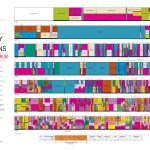Many folks will no doubt be writing a lot about the competitive issues surrounding the announced AT&T/T-Mobile merger, so instead I thought I’d weigh in on what I know best: spectrum.
To the extent you’re worried about the concentration of the wireless market, you should really be concerned about the government policies that make entry and expansion so difficult.
First, if a carrier wants to acquire more spectrum to meet consumer demand for new services, it can’t thanks to the artificial scarcity created by federal policies that dedicate vast swaths of the most valuable spectrum to broadcast television and likely inefficient government uses. It’s gratifying to see the FCC now confronting the “spectrum crunch,” but waiting for a deal to be brokered on incentive auctions is a luxury carriers don’t have. So, buying a competitor might be the only way left for them to acquire more spectrum.
Second, if a carrier wants to put up a new tower, or add antennas to existing towers, it has to get permission from the local zoning board. This can be an extremely onerous process as different localities will have [different reasons to hold up the process](http://www.sfgate.com/cgi-bin/article.cgi?f=/c/a/2010/07/06/BAT01E8QTQ.DTL). Buying a competitor is therefore also an obvious way to get access to more towers.
Again, I’m not sure this merger will have a negative effect on competition. Many high sunk costs industries are [perfectly competitive with just two or three players](http://techliberation.com/2010/05/23/wireless-networks-lemonade-stand-economics/). (I’m look forward to a good analysis on that question, perhaps from our own Geoff Manne of Josh Wright.) What I do know is that if you are worried about competition, antitrust policy is not going to solve the long-term issue of artificial scarcity, which is the real problem here.
Entry is possible. In fact, a new entrant in the wireless market is waiting in the wings in the form of the cable industry with the spectrum they acquired in the AWS auction. Before they can start offering services, however, they must move incumbent users of the bands they acquired. There is also Clearwire, part owned by Comcast, Time Warner, and Google–serious competitors to the Bells.
If we really got serious about reallocating broadcast and inefficiently used federal spectrum, we might not have to worry competition. We’d likely see new entry, and access to spectrum would be less of a reason to acquire a competitor.



 The Technology Liberation Front is the tech policy blog dedicated to keeping politicians' hands off the 'net and everything else related to technology.
The Technology Liberation Front is the tech policy blog dedicated to keeping politicians' hands off the 'net and everything else related to technology.